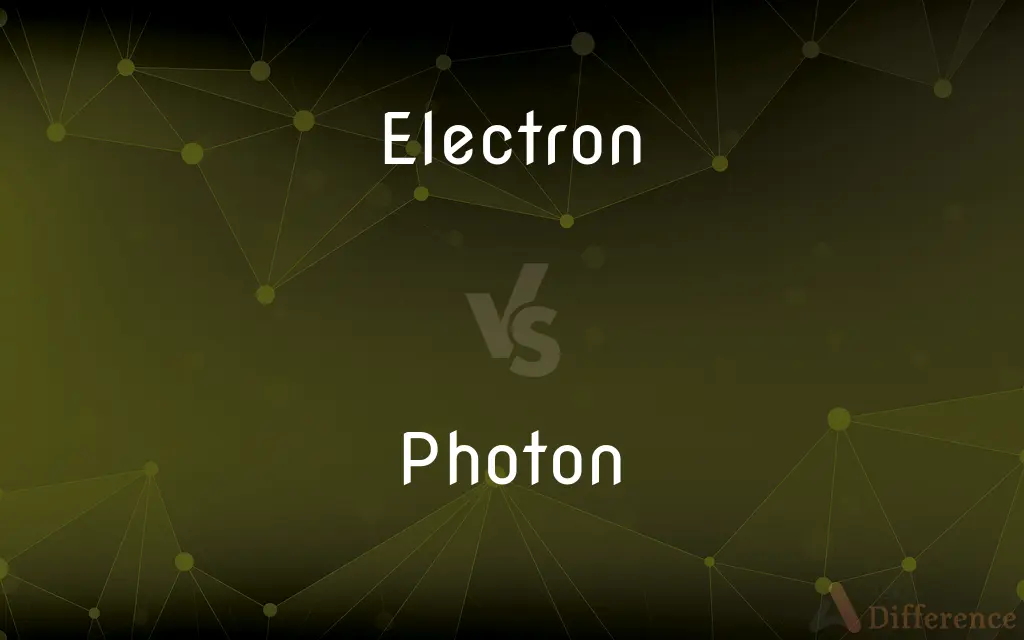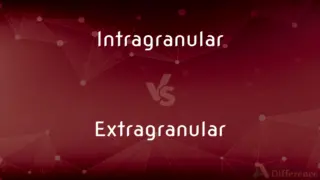Electron vs. Photon — What's the Difference?
By Tayyaba Rehman & Fiza Rafique — Updated on March 30, 2024
Electron is a fundamental particle with a negative charge involved in forming atoms, whereas photon is a quantum of light with no charge, crucial for electromagnetic radiation.

Difference Between Electron and Photon
Table of Contents
ADVERTISEMENT
Key Differences
Electrons and photons represent fundamental concepts in physics, each playing a crucial role in our understanding of the universe. Electrons are subatomic particles with a negative electrical charge, fundamental to the structure of atoms and molecules. They participate in chemical reactions, electricity, and magnetism. Photons, on the other hand, are the quantum particles of light, carrying electromagnetic radiation of all wavelengths, including visible light, radio waves, and X-rays. Unlike electrons, photons are massless and always move at the speed of light in a vacuum.
While electrons have mass and are affected by forces such as gravity and electromagnetism, photons are massless and travel through space at the speed of light. This fundamental difference affects how they interact with matter and energy. Electrons can be bound within atoms or move freely through conductors, playing a key role in electricity and chemistry. Photons, however, are the carriers of electromagnetic force, facilitating interactions at the quantum level without the need for a medium.
In terms of energy, electrons possess rest mass energy, kinetic energy, and potential energy in electrical fields. Photons, conversely, carry energy and momentum proportional to their frequency, following the Planck-Einstein relation. This distinction is pivotal in fields such as quantum mechanics and electromagnetism, influencing technologies ranging from electronics to optical systems.
Regarding behavior, electrons exhibit properties of both particles and waves, a phenomenon known as wave-particle duality. They can be localized but also show interference patterns. Photons also display wave-particle duality, but as quanta of light, their behavior is central to the quantum field theory of electromagnetism, explaining phenomena like photon absorption and emission by atoms.
In the realm of practical applications, electrons are harnessed in technologies like electricity generation and electronics, where their charge and mobility are crucial. Photons are indispensable in optics, telecommunications, and quantum computing, where their properties of speed, wavelength, and absence of charge are exploited.
ADVERTISEMENT
Comparison Chart
Nature
Subatomic particle with a negative charge
Quantum of light with no charge
Mass
Has mass
Massless
Speed
Varies, depending on energy
Constant speed of light in vacuum
Interaction
With electric and magnetic fields
With electromagnetic fields
Role in Technologies
Electricity, electronics
Optics, telecommunications
Compare with Definitions
Electron
Exhibits wave-particle duality.
Electrons display interference patterns in a double-slit experiment.
Photon
Quantum of light.
Photons are emitted when an atom's electron drops to a lower energy level.
Electron
Participant in chemical reactions.
Valence electrons determine an atom's chemical properties.
Photon
Carrier of electromagnetic force.
Photons mediate the electromagnetic force between charged particles.
Electron
Subatomic particle.
Electrons orbit the nucleus of an atom.
Photon
Massless particle.
Photons travel at the speed of light since they have no mass.
Electron
Carrier of charge.
Electrons flow through conductors as electricity.
Photon
Exhibits wave-particle duality.
Photons can demonstrate interference in light waves.
Electron
Influenced by fields.
Electrons are deflected by magnetic fields.
Photon
Energy carrier.
The energy of a photon is proportional to its frequency.
Electron
The electron is a subatomic particle, symbol e− or β−, whose electric charge is negative one elementary charge. Electrons belong to the first generation of the lepton particle family, and are generally thought to be elementary particles because they have no known components or substructure.
Photon
The photon (Greek: φῶς, phōs, light) is a type of elementary particle. It is the quantum of the electromagnetic field including electromagnetic radiation such as light and radio waves, and the force carrier for the electromagnetic force.
Electron
A stable elementary particle in the lepton class having a negative electric charge of 1 elementary unit (about 1.602 × 10-19 coulombs) and a mass of about 9.11 × 10-28 grams. Electrons are found in shells orbiting the nuclei of atoms and can also move freely through space as cathode rays in a cathode-ray tube or as beta particles emitted by radioactive nuclei, or flow in a current through a conducting material impelled by an electric potential difference.
Photon
The elementary particle of light and other electromagnetic radiation; the quantum of electromagnetic energy. The photon is the massless, neutral vector boson that mediates electromagnetic interactions.
Electron
(particle) The subatomic particle having a negative charge and orbiting the nucleus; the flow of electrons in a conductor constitutes electricity.
Photon
(particle) The quantum of light and other electromagnetic energy, regarded as a discrete particle having zero rest mass, no electric charge, and an indefinitely long lifetime. It is a gauge boson.
Electron
Alloys of magnesium and other metals, like aluminum or zinc, that were manufactured by the German company Chemische Fabrik Griesheim-Elektron.
Photon
A quantum of electromagnetic radiation; an elementary particle that is its own antiparticle
Electron
Amber; also, the alloy of gold and silver, called electrum.
Electron
One of the fundamental subatomic particles, having a negative charge and about one thousandth the mass of a hydrogen atom. The electron carries (or is) a natural unit of negative electricity, equal to 3.4 x 10-10 electrostatic units, and is classed by physicists as a lepton. Its mass is practically constant at the lesser speeds, but increases due to relativistic effects as the velocity approaches that of light. Electrons are all of one kind, so far as is known. Thus far, no structure has been detected within an electron, and it is probably one of the ultimate composite constituents of all matter. An atom or group of atoms from which an electron has been detached has a positive charge and is called a cation. Electrons are projected from the cathode of vacuum tubes (including television picture tubes) as cathode rays and from radioactive substances as the beta rays. Previously also referred to as corpuscle, an obsolete term. The motion of electrons through metallic conductors is observed as an electric current. A particle identical to the electron in mass and most other respects, but having a positive instead of a negative charge, is called a positron, or antielectron
Electron
An elementary particle with negative charge
Common Curiosities
Do electrons have mass?
Yes, electrons have a small but finite mass.
How do electrons interact with matter?
Electrons interact with matter through electromagnetic forces, participating in chemical reactions and electricity.
What role do photons play in technology?
Photons are crucial in optics, telecommunications, and quantum computing.
What is an electron?
An electron is a negatively charged subatomic particle that orbits the nucleus of an atom.
Are photons massless?
Yes, photons are massless particles.
Can electrons be used in technology?
Yes, electrons are fundamental to technologies such as electricity generation and electronics.
What is a photon?
A photon is a quantum of light and the carrier of electromagnetic radiation of all wavelengths.
How do photons interact with matter?
Photons interact with matter by being absorbed or emitted, transferring energy in the process.
Do electrons move at the speed of light?
No, electrons do not move at the speed of light; their speed varies depending on energy.
Do photons exhibit wave-particle duality?
Yes, photons also exhibit wave-particle duality.
What determines the energy of an electron?
An electron's energy is determined by its kinetic, potential, and rest mass energy.
How are electrons and photons similar?
Both electrons and photons exhibit wave-particle duality, playing fundamental roles in physics.
Do electrons exhibit wave-particle duality?
Yes, electrons exhibit wave-particle duality, showing both particle and wave-like behaviors.
How fast do photons travel?
Photons always travel at the speed of light in a vacuum.
What determines the energy of a photon?
The energy of a photon is determined by its frequency, following the Planck-Einstein relation.
Share Your Discovery

Previous Comparison
Agitated vs. Irritated
Next Comparison
Intragranular vs. ExtragranularAuthor Spotlight
Written by
Tayyaba RehmanTayyaba Rehman is a distinguished writer, currently serving as a primary contributor to askdifference.com. As a researcher in semantics and etymology, Tayyaba's passion for the complexity of languages and their distinctions has found a perfect home on the platform. Tayyaba delves into the intricacies of language, distinguishing between commonly confused words and phrases, thereby providing clarity for readers worldwide.
Co-written by
Fiza RafiqueFiza Rafique is a skilled content writer at AskDifference.com, where she meticulously refines and enhances written pieces. Drawing from her vast editorial expertise, Fiza ensures clarity, accuracy, and precision in every article. Passionate about language, she continually seeks to elevate the quality of content for readers worldwide.
















































